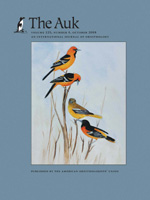The North American Breeding Bird Survey (BBS) provides a widely used source of information on changes in bird population abundance based on data obtained for >50 years by 3-min point counts (Sauer et al. 2005). Rosenberg and Blancher (2005) provided a method that purports to convert BBS data into estimates of absolute abundance. To test this method, we compiled detection efficiencies using BBS protocol at five stations in southern New York where territories of most breeding birds were known. Following the Rosenberg-Blancher method, we assigned species to distance categories, within which it is assumed that the equivalent of 100% of a species will be detected. Field results show that individual detection efficiencies varied from 3% to 49% among 29 species. These values are similar to results from other field studies. Most males did not sing within a 3-min count during June, and the detection distances assumed by the method are much too high. We recommend that conservation priorities of the Landbird Conservation Plan by Partners in Flight should not be based on population estimates derived by such an erroneous method.
How to translate text using browser tools
1 October 2008
Field Tests of the Rosenberg-Blancher Method for Converting Point Counts to Abundance Estimates
John L. Confer,
Rebecca E. Serrell,
Mark Hager,
Eleanor Lahr
ACCESS THE FULL ARTICLE

The Auk
Vol. 125 • No. 4
October 2008
Vol. 125 • No. 4
October 2008
Breeding Bird Survey
detection efficiency
landbird conservation plan
Partners in Flight
point count




